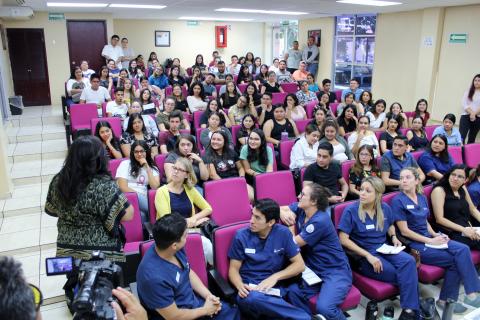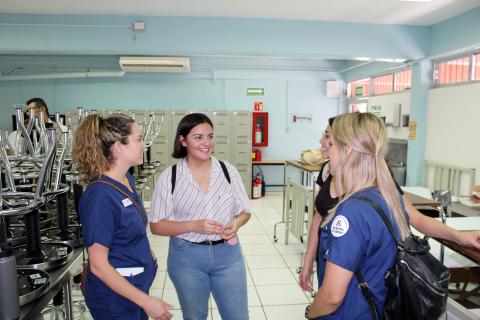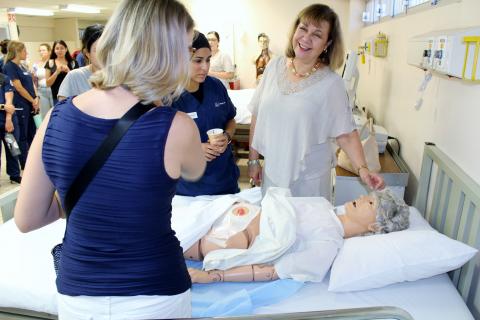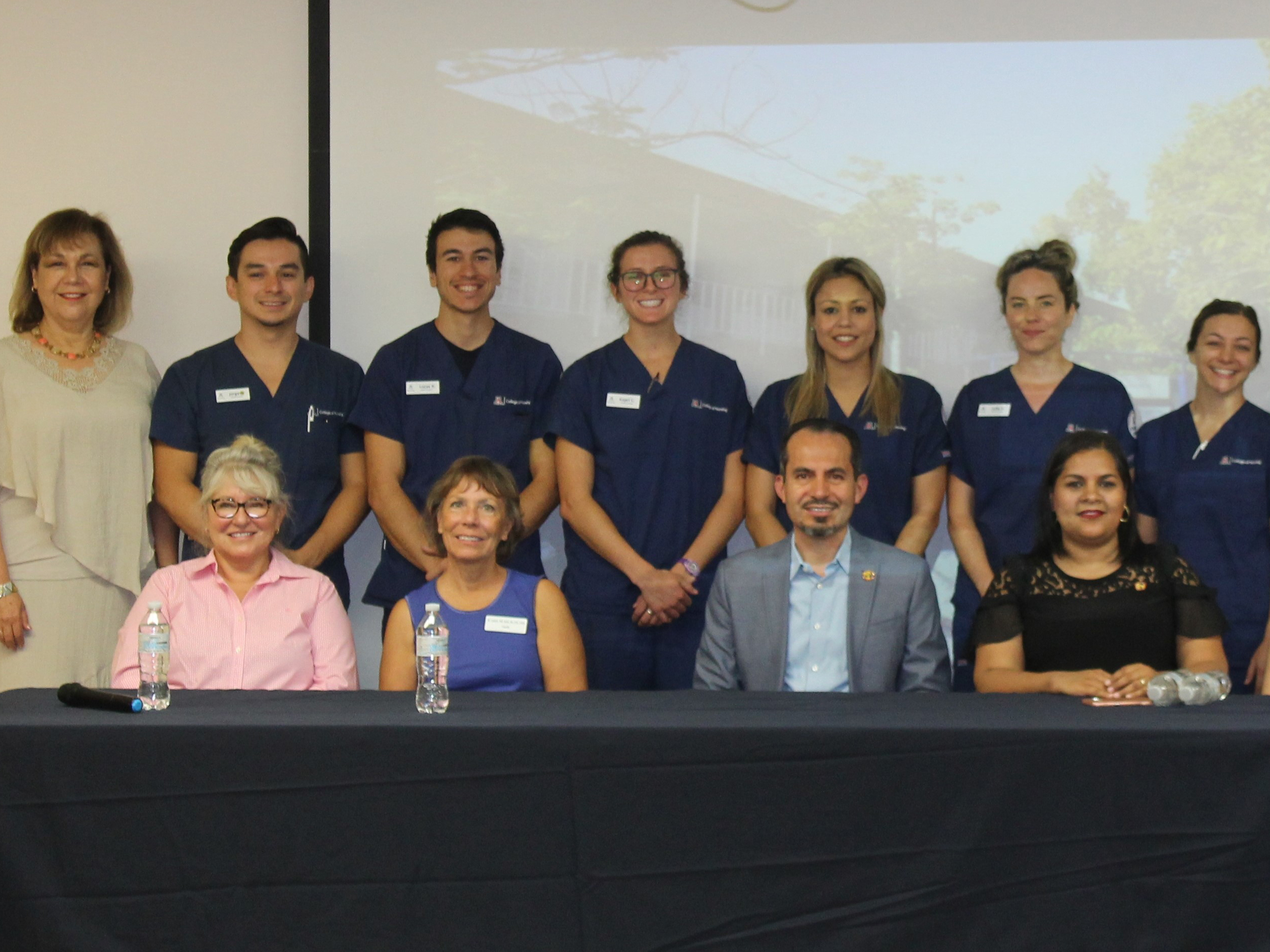UArizona Nursing MEPN Students Shine in Border Bi-National Clinical Experience
Last summer, eight students in the University of Arizona College of Nursing Master’s Entry to the Profession of Nursing (MEPN) program participated in an immersive clinical experience with the Department of Nursing, University de Sonora (UNISON), a public university in Hermosillo, Mexico.
The binational clinical experience was the brainchild of UArizona Associate Dean for Global Nursing, Marylyn Morris McEwen, PhD, RN, FAAN, and Nursing MEPN Program Coordinator Wanda Larson, PhD, Med, RN, CEN. Eight students in their Population and Community Health Nursing course participated in the pilot program. The students completed half their clinical time – or 45 hours – in Hermosillo over the course of the five-day program. Once the students returned to Tucson, they completed the remaining 45 clinical hours by developing and implementing two culturally tailored interventions for migrant populations based on the community assessment conducted in Hermosillo, MX and extended in Tucson.
“This was a maiden voyage with the goal of integrating this amazing geopolitical context into our community public health nursing rotation,” said Dr. McEwen, who has 30 years of trans-border health care and teaching experience. “Dr. Larson’s expertise in the health systems, culture and history of Mexico, enriched the student experience.”

Students were able to compare and contrast the health care systems – both acute and public health - of each country. “We brought a border binational focus to the curriculum,” Dr. Larson said. “Students were able to identify binational strengths, differences and similarities and, develop hopefully lifelong relationships with UNISON nursing students in just a few short days.”
The fast-paced program, which often immersed faculty and students in 16-hour days, allowed MEPN students to conduct a comprehensive community assessment. The assessment considered factors such as history, epidemiological and population data, and how the health of the community is influenced by local health care systems, politics, government, education, transportation, safety and communication. Students from UNISON’s baccalaureate program paired with UArizona Nursing students, embarking on an academic journey to understand population-level health and health care systems in Sonora, Mexico.
“Our UNISON nursing faculty partners carefully selected the student ambassadors who worked one-on-one with our MEPN students,” said Dr. Larson. “UNISON students were fluent in English and Spanish, decreasing language barriers contributed to an effective the partnership because content and concepts could be delivered in both languages. Our students crossed the border with a smattering of Spanish, but returned five days later with a greater understanding of binational health issues due to the rich immersion experience. They learned to tune in empathetically to all the nonverbals of what was going on with the people they were interacting with.”

Claire Bethel, a UArizona Nursing PhD student who was part of the group, added, “Our students were hungry to have discussions with our health care colleagues in Sonora regarding public health issues facing immigrant communities. This is especially important considering our geographic location as the largest city in Southern Arizona closest to the US-Mexico border. As future nurses, the students were eager to learn about how they could take what they learned from this experience to provide better care to immigrant communities at home in Tucson.”
The Hermosillo experience culminated with an interdisciplinary community health fair delivered at a colonia, an acutely disadvantaged community on the outskirts of the city. The pop-up fair featured health promotion and risk reduction health education about public health issues such as healthy diet, vaccination, pap smears, breast exams, diabetes, dental health and accessing public health services.
This experience proved pivotal once the UArizona nursing students returned north of the border. “Much of the colonia is composed of migrant communities and there’s a lot of abject poverty,” said Dr. Larson. “Our students were able to compare and contrast binational migrant health issues after conducting a focused community assessment of Tucson South side neighborhoods.”

Bolstered by their new insights, students divided into two groups to develop interventions based on analysis of the binational community assessment data. The next step was to identify a population-level nursing diagnoses to focus risk reducing and health promoting interventions for a similar population in the U.S. Students chose migrant families in the Catholic Community Services of Southern Arizona’s Casa Alitas program as the recipient of their interventions. Casa Alitas provides care and short-term shelter to migrant families who have left their home countries to escape violence and poverty.
“The students were able to contextualize their experience because of the knowledge they gained in Sonora about the migrant population,” said Dr. McEwen. “Students were concerned about being responsive to the health care needs of migrants seeking asylum in the U.S. from Mexico as well as Central America. Students were committed to providing culturally tailored interventions for this vulnerable population.”
One intervention focused on ways for people to stay hydrated using inexpensive rehydration fluids with the correct balance of sugars and salts. The second intervention zeroed in on ways to manage stress. Stress is a major factor for migrants who are briefly with Casa Alitas and are coping with the major upheaval of adjusting to a new country and language, often before journeying across the country to connect with family members or other services.
“Casa Alitas staff were so impressed with the intervention,” said Dr. McEwen. “And the migrants were grateful for the information and strategies they received, real things in terms of breathing, in terms of soothing teas, strategies that are portable because they’re on the move.” The educational intervention was conducted in a hotbed of stress, the room in which continually operating monitors inform migrants when the next phase of their journey will begin, whether it is by train, bus or plane. “There are layers and layers of stress, because these are families have been broken apart, waiting to move to the next step,” said Dr. Larson. “It was amazing what these students did, their interventions were on target and well received by the migrants.”
Drs. McEwen and Larson were pleased with the binational component of the clinical experience and with students who exceeded learner outcomes for the course. They plan to offer the binational experience as an option within the MEPN Population and Community Health Nursing course next year. With positive results for both our partners at UNISON and our UArizona Nursing students, the cultural and health systems immersion was a vibrant success. “I think it is safe to assume that these students have been changed as nurses,” said Dr. McEwen. “They will see their patients in the future very differently than students who have not had this kind of global opportunity. In their role as nurses, when their patient is not from our country or speak the English language, they’re going to ask ‘How do I best communicate with this individual? How can I best advocate on their behalf? What might their cultural beliefs and values be about the health care they are expecting to receive? And how can we help them understand how health care delivered in the U.S. might differ from health care in their country of origin?” The Hermosillo clinical rotation is aligned with the College of Nursing Global Strategic Plan for providing binational student experiences in partnership with our nursing colleagues in Mexico.


